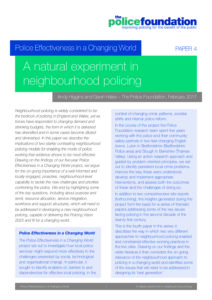In the months preceding the 2015 Comprehensive Spending Review (CSR), the language used to describe the style of policing that would need to be adopted if further funding cuts were imposed became increasingly vivid. Senior figures evoked a bleak future in which policing would be reduced to a paramilitary’ or blue light’ emergency service, taken back to the 1970s’ and forced to operate without its golden thread’ of vital grass-roots intelligence. They were imagining a nation that could no longer afford neighbourhood policing.
These warnings were not without basis. From a point of relative national consistency in 2008, at the end of the Neighbourhood Policing Programme, austerity and policy devolution have given forces the imperative and freedom to adapt their workforce and operating models to challenging new demand and funding conditions.
This has led to innovation, variation, and sometimes attrition in the resources and responsibilities allocated to neighbourhood policing teams. In some places it has meant combining neighbourhood roles with elements of response and investigation, in others to a loosening of the designation of officers to place. In some forces PCSOs are increasingly relied upon to do local engagement and problem solving work, while in others their numbers have been substantially reduced. Some places have simply had their neighbourhood policing functions all but withdrawn.
The Police Foundation has been well placed to observe the real consequences of these developments; they maybe less sensational than those prophesied, but are just as important.
The latest paper from our Police Effectiveness in a Changing World series tells the story of two attempts to develop and implement problem-oriented, evidence-based, multi-agency responses to persistent crime problems, in two towns Luton (Bedfordshire) and Slough (Thames Valley) where, co-incidentally, very different approaches to neighbourhood policing had been taken.
In Slough, where a well-established, traditional’ neighbourhood function had been maintained, neighbourhood officers took a key role in delivering a new process for tailoring case-level interventions to individuals recurrently involved in violence. They were able to combine improved information flows with their local knowledge to identify and engage those at risk and better coordinate activity with a range of partner services.
In Luton, where (during 2014/15) neighbourhood policing had been drastically scaled back to protect (supposedly) core’ functions (particularly response and investigation), significant difficulties were encountered in delivering an initiative aimed at strengthening home security and community resilience in burglary hotspots. Finding personnel to complete tasks that weren’t about what’s happening now’ was a constant challenge, the skills and systems needed to organise and carry out pre-planned, proactive work were under-developed, and, perhaps most importantly, the police’s ability to secure the cooperation of local people in policing efforts was, by their own admission, severely undermined.
This natural experiment’ shows the real value of neighbourhood policing; the ability to deliver informed proactivity. When done well, neighbourhood policing provides the capacity to respond to on-going problems’ rather than just reacting to incidents, to understand the specific risks and dynamics of places and communities, to involve others in delivering creative, preventative solutions, and to develop personal relationships with local people and businesses, as the basis for influencing decisions. Evidence reviews, including our own, tell us that these things work; doing them should be considered a core’ policing function.
More than a year on from the (at least partial) reprieve offered by the CSR, there is some cause for optimism. Bedfordshire has changed its policing model to provide more local resource and a renewed focus on problem solving, the Metropolitan Police Service is talking about a return to real’ neighbourhood policing and The Policing Vision 2025, signed up to by all forces and PCCs, has set out high-level commitments to focus on proactive prevention, tackle recurring problems, support community building, share data better and invest in analytics.
Localism means that forces will work towards the Vision in their own ways and, inevitably, with different emphases, however parallel journeys can be guided by a unified evidence-base and aided by conceptual clarity and common language. It will not be enough to have more officers and staff with neighbourhood’, local’ or community’ in their job title; it’s what those people do and how they are equipped and enabled that is important. As the Foundation’s research on the local impacts of organised crime has shown, neighbourhood teams are often under-optimised and under-utilised for their core function’ of collecting and using information to prevent crime and keep local people safe.
Meeting the local policing challenges of today and tomorrow will require greater clarity on what neighbourhood policing is for, what functions it should (and should not) perform, and how policing styles and scarce resources can best be matched to increasingly dissimilar neighbourhoods. In addition, as the Vision 2025 suggests, it will be important to better align neighbourhood policing with local partner service; it will be just as important, however, to improve the way it is connected to, and supported by, the rest of policing.
The Police Foundation’s latest paper A natural experiment in neighbourhood policing from its Police Effectiveness in a Changing World project is published today.
The Police Foundation has launched a new research project to explore the Future of Neighbourhood Policing. Find out more or register your interest.

